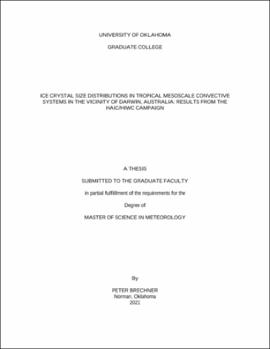| dc.contributor.advisor | McFarquhar, Greg | |
| dc.contributor.author | Brechner, Peter | |
| dc.date.accessioned | 2021-12-15T14:28:52Z | |
| dc.date.available | 2021-12-15T14:28:52Z | |
| dc.date.issued | 2021-12 | |
| dc.identifier.uri | https://hdl.handle.net/11244/332327 | |
| dc.description.abstract | Total ice water content (IWC) derived from an isokinetic evaporator probe and ice crystal size distributions measured by a two-dimensional stereo probe and precipitation imaging probe installed on the French Falcon aircraft during the collaborative European High Altitude Ice Crystals – North American High IWC field campaign (HAIC-HIWC) based out of Darwin, Australia in 2014 are used to characterize high IWC regions (areas with IWC greater than 1.5 g m−3 and median mass dimension (MMD) less than 0.5 mm, hereafter HIWC regions; areas with IWC greater than 1.5 g m−3 with any MMD are hereafter high IWC regions). A fitting routing that automatically determines whether a unimodal, bimodal, or trimodal gamma distribution best fits an observed size distribution was developed and used to determine the characteristics of the size distributions (e.g., presence of unimodal/bimodal/trimodal distributions, fit parameters characterized by volume of equally realizable parameters to account for variability and uncertainty, etc.). The variation of these characteristics and bulk properties (median mass diameter, IWC) were determined as a function of temperature, IWC, and vertical velocity. HIWC regions were most pronounced in updraft cores. The three modes of the size distribution give information on different processes contributing to ice growth: nucleation for crystals with maximum dimension D < 150 μm, diffusion (150 μm < D < 1000 μm), and aggregation (D > 1000 μm). The occurrence frequency of trimodal distributions increased with temperature. The volumes of equally plausible parameters derived in the phase space of gamma fit parameters increased with temperature for unimodal distributions. For multimodal distributions, the volumes increased with temperature for temperatures less than −27°C. Bimodal distributions with a nucleation mode were most common in updraft cores and HIWC regions, whereas bimodal distributions with an aggregation mode were least common in updraft and downdraft cores. | en_US |
| dc.language | en_US | en_US |
| dc.rights | Attribution 4.0 International | * |
| dc.rights.uri | https://creativecommons.org/licenses/by/4.0/ | * |
| dc.subject | Atmospheric Sciences. | en_US |
| dc.subject | Cloud Physics | en_US |
| dc.subject | Meteorology | en_US |
| dc.subject | HIWC | en_US |
| dc.title | Ice Crystal Size Distributions in Tropical Mesoscale Convective Systems in the Vicinity of Darwin, Australia: Results from the HAIC/HIWC Campaign | en_US |
| dc.contributor.committeeMember | Sakaeda, Naoko | |
| dc.contributor.committeeMember | Wu, Wei | |
| dc.date.manuscript | 2021-10 | |
| dc.thesis.degree | Master of Science in Meteorology | en_US |
| ou.group | College of Atmospheric and Geographic Sciences::School of Meteorology | en_US |

